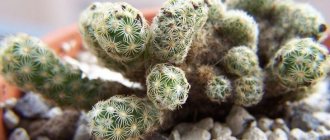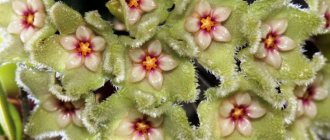Cereus varieties
There are many types of cereus plants:
- Validus. The bluish stem and snow-white flowers of Cereus look very harmonious and aesthetically pleasing.
- Carnegia - its homeland is located in the desert American states, and the flower of this plant is a symbol of Arizona. This cactus produces reddish edible fruits. Cristata is a cactus native to Peru. Its trunks are spherical and grow tightly in relation to each other. Small spines grow from the ribs.
- Azureocereus. Its azure shade immediately attracts attention, as well as its fairly large stem with significant branching. One of the features of this variety of cereus is the corollas, which emit a strong aroma.
Kinds
The genus Cereus has 48 official species, but there are another 450 different names that are of uncertain status.
Peruvian, nocturnal cereus, or repandus (Cereus repandus)
This is a large plant, highly branched. Stems can be whole or segmented. In nature it grows up to 10 m. The ribs of this type of cactus are shallow and located vertically. There are many areoles, the spines in them are short, straight, strong, and light in color, although some specimens may not have spines at all.
Buds form along the entire stem. The flowers are large (up to 15 cm in diameter), cream-colored, attached to long flower tubes. There are a lot of petals. The flowers bloom at night and bloom for only one day. The fruits are round in shape, up to 6.5 cm in diameter, red, sometimes orange, when ripe, edible.
At home, achieving flowering is quite difficult, but possible. To do this, it is necessary to create conditions as close as possible to natural ones. But due to the nighttime and short-term flowering, it is difficult to enjoy it.
Peruvian Florida (Cereus peruvianus Florida)
A variety of Peruvian cereus. A characteristic feature is the dark green color of the stems.
Rocky or monstrous (Cereus monstruosus)
In this type of cactus, the lateral branches grow together, forming bizarre shapes. No two rock cacti are alike. They grow in nature to enormous sizes. They produce edible fruits.
Grown as hedges. More recently, these plants were used as wood in construction (boards were cut from them), to strengthen roofs, as feed for livestock during drought, and also to make dishes for various liquids.
Spiral (Spiral, Cereus brasile)
Has fleshy stems. The vertical ribs are twisted in a spiral. The spines are strong, two to three centimeters long. The flowers bloom at night, fragrant, white and pink.
Christata
Cereus rocky and azure can have a cristate (monstrous) form.
Azure, or azureocereus (Cereus azureus)
This cactus is also called blue for the green-blue color of the stems with a silver tint. These plants grow slowly and eventually turn into trees. There are a lot of ribs - up to 20.
A distinctive feature is the presence of parallel side shoots. The total diameter of the cactus is up to three meters. Straight spines up to 10 cm long, very hard and strong. Blooms at night, flowers up to 5 cm in diameter, white.
Strong, or validus (Cereus validus)
This is a shrubby species of cereus - it grows up to two meters in height. The stem is straight, branched, light or bluish green. On the stems there are up to seven wide ribs.
There are five to eight side shoots. The spines are rigid, arranged in a bunch - the central ones are longer. The flowers are usually snow-white, but red ones are also found.
Paolina (Cereus peruvianus f. Paolina)
Columnar cactus grows up to three meters. Branches at the base. The diameter of the stems is 10–20 cm. Young plants have a light green color, but with age it becomes blue-green.
There are usually seven ribs, their depth is up to three centimeters. Each halo has five or six radially arranged hard spines. The flowers are white, large, and bloom at night. Ripe fruits are coral-red in color.
Jamakaru (Cereus jamacaru)
The cactus is tall, the stems are erect, segmented, and can be green or green with a blue tint. Many mature plants branch at the base. The ribs are deep. The spines are small and light. With age, the stems become covered with brown bark and become woody.
Buds can appear throughout the body of the cactus, but more on the tops. Flowers bloom at night. They are cream-colored, large, with a strong aroma, attached to long flower tubes.
The petals are thin and long. The fruits turn red when ripe and can be eaten.
Forbes (Cereus forbesii)
A tree-like cactus that grows in natural conditions up to seven meters. Strongly branched. The stems are green, sometimes with a blue coating, and cylindrical. Adult cacti become covered with bark and become denser.
Deep ribs are located vertically. The areoles are “woolly”, the spines in them are short, very durable, and light in color.
Blooms at night. The flowers are located on the sides of the stems, very large, and can be white, cream or pale pink. The fruits are pinkish, round in shape, smooth surface.
Forbes spiral (Cereus forbesii spiralis)
Sometimes you can see the name “Forbesy Spirals”. This species is considered a mutant of Cereus Forbes, but botanists are skeptical about this version. The cactus has the shape of a candelabra - the main tall stem, and numerous additional ones extend from it at the base.
All of them are straight, up to five meters or more in height, cylindrical, with a diameter of 10–12 cm. Ribs from five to nine. They are widely spaced and really spiral. The flowers are located on the sides, their petals are snow-white with a soft pink edging.
Uruguayan (Cereus uruguayanus)
The cactus is tall, distinguished by slender thin shoots, which can be not only solid, but also segmented. Strongly branched at the base. The stems are green and bluish-green in color.
The ribs are deep and vertical. Straight, strong and long spines grow in a bunch in the areoles.
The buds are laid along the entire length of the ribs. The flowers are attached to long tubes. They come in white or cream. Their diameter is 10–12 cm. The aroma is strong and pleasant. Blooms at night.
Giant, or carnegia (carnegia gigantea)
It is also called the desert giant. This is a very large and tall cactus that can grow up to 15 m in height and have a trunk diameter of up to 70 cm. The root goes deep up to one meter and has a rod-like shape.
In large specimens, lateral branches (from 8 to 12) grow at the base of the trunk, the height of which is 4 m. The ribs of this cactus are straight with densely spaced areoles, the color is gray-white. The four-centimeter spines are thick and can be golden brown or gray.
The flowers are white with a yellow center, bell-shaped, up to 7 cm in diameter, with a pleasant and strong aroma. The buds are laid at the top.
Each flower remains open for only one or two days, but since there are many of them and they bloom gradually, the total flowering lasts up to two weeks. The fruits are small - 7–8 cm in length and 4.5 cm in diameter; when fully ripe they are red.
Optimal lighting
You need to make sure there is sufficient lighting for the succulent. But you shouldn’t overdo it - he should get used to the light gradually.
Place at a distance from a source of natural light, direct rays should not fall on the plant, then gradually move the cactus towards the window. Cereus thrives in any temperature (but don't put it in the refrigerator).
The most comfortable temperature for this exotic plant in winter is up to twelve degrees. In summer, this temperature reaches thirty degrees. It is better if the plant lives in a room whose windows are located on the south or southeast side. In the summer, take the cereus out to the balcony.
Botanical description and homeland of the plant
Cereus (lat. Cereus) is a giant among cacti, its height is 6-10 m, there are twenty-meter representatives.
It breaks records for life expectancy, as it can grow in nature for up to 300 years. In total, there are 50 species of cereus, common in South and Central America and the West Indies. Most of them are tall, well-branching shrubs; there are low-growing and creeping plants (clinging with the help of lateral shoots).
Cereus is characterized by a cylindrical structure of shoots, divided into several well-defined edges. Against the background of the green-gray tint of the stems and shoots, the dark brown, almost black spines stand out, although at first they are almost white. The name of the plant is translated from Latin as “wax candle”.
Cereus is perfect for growing indoors: it is not demanding, reproduces well, grows quickly and has proven itself to be an excellent rootstock. A highly decorative plant will decorate a room, winter garden, or shop window. Cereus is often used to create cactus slides.
Cereus flowering
How Peruvian Cereus blooms photo
In nature, Cereus regularly blooms in May-June; the bush is decorated with many corollas. In indoor conditions it can bloom in the fall, of course there are not so many corollas. Flowers are located laterally (on the side of the shoots). They are large, the petals are snow-white, beige or pinkish, the core is golden.
How Cereus spiral blooms photo
An individual flower lasts no more than a day, but manages to impart an intoxicating aroma. It is intense and vanilla-like, so ventilate the area if you are sensitive to odors.
Cereus peruvianus monstrous form as it blooms photo
The fruits are red or yellow berries and can be eaten.
Replanting a cactus
A cactus that is up to three years old must be replanted every year. In this case, you need to prepare a larger container for transplantation. If the cereus is older, it should be replanted every two to three years. If your plant has reached a height of half a meter, replant it at your discretion, it is important to replace the surface layer of soil each time.
How do Cereus reproduce?
Both seeds and cuttings are suitable for this purpose. If you choose the first method, you should start planting the seeds in the spring, and pour a thin layer of sand, slightly moistened with water, on top. Place the workpiece where the temperature is from twenty-two degrees.
To create the necessary humidity, cover the top with a piece of glass or plastic. If your choice is cuttings, take the strongest one and separate it with a knife. First dip the knife into boiling water.
Ventilate tissue defects on the stem in the air for two days. After planting, the cuttings produce roots after four to six weeks. Water with a small amount of water.
Reproduction
Pilosocereus reproduce only by seeds. Growing cacti from seeds is not an easy task, but if the necessary conditions are met, it is achievable.
To begin with, cactus seeds are planted separately in prepared peat tablets. Then conditions for germination are created by placing them in a mini-greenhouse with temperature and humidity levels of +25 ° C and 55%, respectively.
After a few weeks, the formation of small pilosocereus can be observed on the soil surface.
After another 6-8 weeks in this mode of maintenance, small cacti will become a little larger. At this time, you can try to transplant young Pilosocereus into larger containers and adapt them to their new habitat. In the next month, protect cacti from direct sunlight.
Diseases affecting Cereus
Problems can arise with excessive humidity and during cold periods. Adequate drainage is also important.
Major pests
Felt. If you see a white coating similar to cotton wool on your indoor cactus, immediately start spraying your pet with a solution of soap and alcohol or Aktellika, Fitoverma.
Spider mite. You may see small defects on the leaves, as well as cobwebs. To prevent the process from falling off, use Actellik and sulfur powder; you can wash the plant first.
Shield. Yellowish spots, sticky drops on the foliage. To prevent the leaves from drying out, use a solution of soap and alcohol, garlic infusion, Fitoverm, Fufanon.
All these tips will help you grow a beautiful unusual plant. It will decorate your home and create a cozy atmosphere. And you can also take a great photo of the cereus and show it to your friends. Caring for plants is real work, and you can get a lot of joy from this rewarding process.
Home care
Cereus is a rather unpretentious plant.
Even a novice gardener will be able to learn how to care for it.
Features of care after purchase
Proper plant care begins with replanting. Unfortunately, many do not pay attention to this and subsequently encounter problems. Before buying a flower, take care in advance to purchase a suitable container and substrate.
- Selecting a container The pot is selected approximately 1 size larger than the previous one. The container should not be deep, but wide. The root system of the flower is weak. It is necessary to add drainage to the bottom.
- Choosing soil The best option is to buy a ready-made mixture for succulents and cacti. You can prepare the soil yourself from turf and leaf soil (in equal proportions), add brick chips, sand and peat.
Lighting
Cereus loves good lighting.
The best place for a flower in the house is open, bright window sills facing south.
In summer, in warm, sunny weather, take the flower outdoors.
So that he can ventilate and bask in the sun.
If there is a lack of light in winter, it is recommended to take care of additional artificial lighting.
The flower reacts negatively to lack of light.
Please note that the plant is sensitive to changes in environment and lighting.
Temperature
In spring and summer, the cereus will be comfortable in a room with a warm or moderate temperature (20-25 degrees). In winter, a period of rest begins.
The plant overwinters at a temperature of 14-17 degrees.
Air humidity
The plant does not require additional moisture. Only on hot summer days can you spray it with water to freshen it a little and clean it of dust.
Watering
In summer and autumn, watering should be regular but moderate. The plant does not tolerate a lack of moisture well, but an excess can lead to the formation of root rot. In autumn, watering is gradually reduced.
In winter, the flower is not watered.
Fertilizers
In its natural environment, the cactus grows in soil depleted of nutrients, so it is well suited for growing without special fertilizing.
If you want to feed the plant, it is recommended to do this only in the summer and no more than once every 3-4 weeks.
It is better to use special fertilizers for succulents and cacti.
Bloom
The deadline falls in spring and early summer.
To start flowering, it is especially important to follow proper care during the dormant period. During flowering, it is recommended to slightly increase the frequency of watering.
During flowering, it is recommended to slightly increase the frequency of watering.
Transfer
Cereus is transplanted in March or early April.
A young plant is replanted annually, and an adult plant only as needed (about once every 2-3 years).
Please note that the flower has a very fragile, weak root system. Be careful when removing it from the pot
It is better to replant an adult plant together so as not to damage it.
Reproduction
Most often, cactus is propagated by cuttings. Before planting, they are dried for several days and then dipped into a moist substrate.
The cutting must be secured in a vertical position until it takes root.
Seeds are propagated less frequently. This process requires a lot of time and effort.











